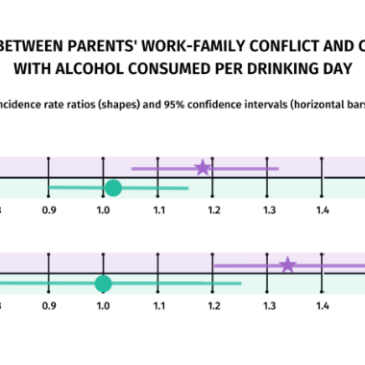Most working parents struggle to balance work and family demands, which can lead to poor mental health. While having a drink may help them feel relaxed in the moment, alcohol can make things worse in the long run. This week, The DRAM reviews a study by Sandra Kuntsche and Emmanuel Kuntsche that examined the association between work-family conflict, coping motives, and alcohol use among mothers and fathers of preschoolers in Switzerland.
What were the research questions?
What is the association between work-family conflict and alcohol use? Do coping motives mediate this association?
What did the researchers do?
Parents of 3- to 6-year-olds who attended one of 44 selected preschool classes or nurseries in Switzerland were recruited to be part of the study. A total of 165 mothers and 144 fathers completed a questionnaire about alcohol use, drinking motives (coping, social, enhancement, conformity), work-family conflict, age, employment level, and number of children. The two alcohol use measures were usual quantity per drinking day and frequency of risky single occasion drinking (RSOD)1. The researchers analyzed the responses of mothers and fathers separately using Poisson regression. They took into account non-coping drinking motives, age, and employment.
What did they find?
Mothers and fathers reported similar levels of work-family conflict. Most fathers (93.1%) were employed four days a week or full time, but only 21.2% of mothers reported the same level of employment. Fathers consumed more alcohol and had more frequent risky drinking occasions than mothers.
Mothers experiencing higher work-family conflict reported drinking more alcohol per drinking day (see Figure, top row). Mothers with a stronger tendency to drink to cope also drank more alcohol per drinking day (see Figure, second row). Coping motives also helped explain the association between work-family conflict and alcohol use among mothers. No associations were found between work-family conflict, coping motives, and alcohol use among fathers.
 Figure. Associations among mothers are shown above the number line (purple) while associations among fathers are shown below the number line (green). Shapes represent incidence rate ratios and horizontal bars represent 95% confidence intervals. (An incidence rate ratio of 1.0 means no effect of a given exposure on health outcomes, in this case work-family conflict or coping motives on usual drinking quantity.) A star indicates a statistically significant association. Click image to enlarge.
Figure. Associations among mothers are shown above the number line (purple) while associations among fathers are shown below the number line (green). Shapes represent incidence rate ratios and horizontal bars represent 95% confidence intervals. (An incidence rate ratio of 1.0 means no effect of a given exposure on health outcomes, in this case work-family conflict or coping motives on usual drinking quantity.) A star indicates a statistically significant association. Click image to enlarge.
Why do these findings matter?
Mothers who drink to cope consumed more alcohol and had more risky drinking occasions when facing work-family conflict. Though the percentage of stay-at-home dads is increasing, mothers still tend to fulfill a larger share of household responsibilities. Thus, it may not be gender but an unfair percentage of the family maintenance workload that propels mothers to drink to cope. Interventions should help parents coordinate their workloads to reduce stress and conflict, as well as identify those who drink to cope and provide them with support and non-drinking alternatives, such as relaxation techniques, to cope with stress in a healthier way. Organizational changes including family-friendly policies and living/thriving wages might do even more to create an equitable and healthy society.
Every study has limitations. What are the limitations in this study?
This study analyzed cross-sectional data, so we cannot determine whether experiencing higher levels of work-family conflict causes someone to drink more, or whether those who already have high alcohol use experience higher work-family conflict as a result of their drinking. There was also no inclusion or consideration of the LGBTQ+ community in the study.
For more information:
The National Institute on Alcohol Abuse and Alcoholism also has tips and resources for people struggling with problem drinking. For additional drinking self-help tools, please visit our Addiction Resources page.
— Caitlyn Fong, MPH
What do you think? Please use the comment link below to provide feedback on this article.
________________
[1] Risky single occasion drinking (RSOD) is defined as consuming five or more drinks for men and four or more drinks for women.




